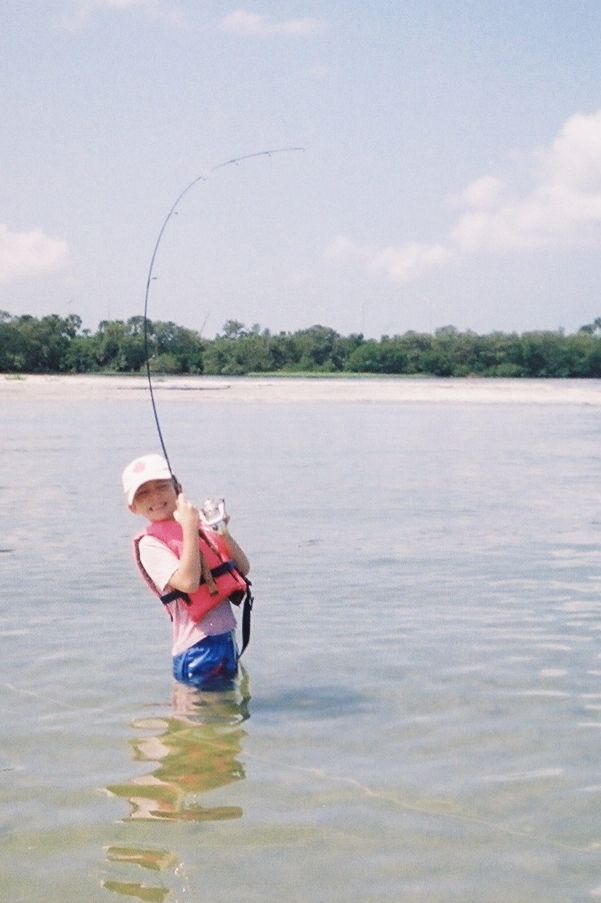Mild fall temperatures dominated in the Tampa Bay area this week, but the action at the Sunshine Skyway Fishing Piers was anything but mild for many species of fish. Schools of aggressive bluefish invaded the piers and are providing fast action in the daylight and overnight hours. Ladyfish and jack crevalle joined in the fray of predators slashing through baitfish schools. It was tougher to catch a limit of Spanish mackerel this past week than last week, but that was mostly because smaller mackerel had to be ‘fished through’ to get the larger specimens. Mangrove snapper continue to be taken and some visitors procured nice limits of fish. Gag grouper were hitting free-lined offerings, as were many species of sharks and tarpon hovering near the piers.
Bluefish are being caught in good numbers at both fishing piers, but the action is especially frantic on the South Pier. Bluefish are pelagic (migratory) by nature, and generally visit the Tampa Bay estuary in the cooler months. The species boasts incredible speed and unrivaled ferocity. Although the fish that visit the piers are nowhere near the size that inhabit the mid-to-northern U.S. east coast, the Tampa Bay fish can range up to 5 + lbs. and will put a good test to medium / light spinning tackle. Silver spoons, white nylon jigs and Gotcha lures are all very effective artificial lures for bluefish. Bluefish can be spotted by pier anglers when they are feeding on baitfish schools because they will often churn the water like a boiling pot of water and even leap into the air in pursuit of their prey. The prey this past week was glass minnows (often very small scaled sardines or threadfin herring) and the baitfish schools would explode like drops of rain when the blues hit the bait ball.
Bluefish are very commonly eaten on the northeast seaboard of the United States, but seem to have more of a lackluster following in Florida. Perhaps residents in the Sunshine State prefer the more mild flavor of snapper and grouper, but equally likely is that Florida residents are unfamiliar with the preparation of this species. If planning to eat bluefish, bleed them in a bucket of water immediately after you catch them and then place them on ice in a cooler. The firm texture of this species remains even after cooking, so they are an ideal species to use in cream & cheese based bakes or chowders.
Spanish mackerel were on an intermittent bite throughout the fishing week, but this was mostly because too many mackerel were hovering just under the minimum size limit required by the Florida Fish & Wildlife Conservation Commission (FWC). Anglers willing to sort through smaller mackerel were able to get a few very nice fish – including some very large representatives in the 22″ plus class. Some experienced mackerel anglers turned to multiple hook artificial lures, rigs and jigging styles to produce mackerel this past week. Gotcha lures, mackerel trees and larger sabiki-style bait rigs took plenty of mackerel and thus allowed visitors to weed through smaller fish in pursuit of some keepers. King mackerel did remain around both fishing piers and some nice catches did occur. Anglers free-lining blue runners did best by taking a few kings in the 30 lb. class. Most kings were taken on the North Pier, but action should also spread to the South Pier as the season ages.
Sharks of many species excited visitors not familiar with saltwater fishing as blacktip and sharpnose sharks attacked baits seeking a much smaller adversary. Many anglers who have never caught a shark notched their first catch from a ‘toothy-critter’ over the past week. Perhaps the most effective method was simply to free-line or anchor a small pinfish using only light wire and a sturdy hook at the terminal tackle end. Freshwater anglers can bring their bass & catfish tackle to tame these smaller sharks that are not only loads of fun to catch, but also simply fantastic when placed on the grill
- The Skyway, Paul Bristow - August 24, 2018
- The Skyway, Paul Bristow - August 17, 2018
- The Skyway, Paul Bristow - August 10, 2018










